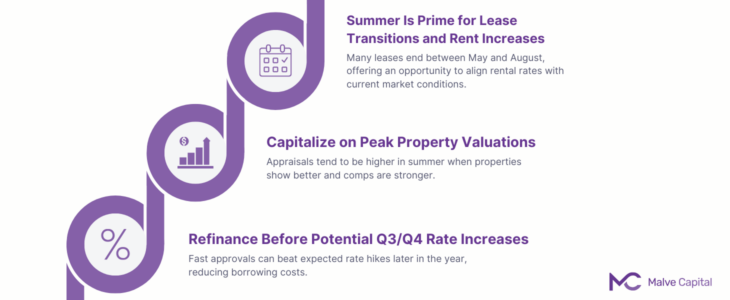For real estate investors focused on long-term wealth building, timing your refinance matters just as much as finding the right lender. Summer offers unique advantages for refinancing rental properties—especially if you’re looking to pull cash out to fund your next deal, lock in a long-term fixed rate, or lower monthly payments to boost cash flow.
At Malve Capital, we specialize in fast, flexible financing designed for investors. Here’s why now is the time to act:
Summer Is Prime for Lease Transitions and Rent Increases
Summer is the most common time for tenant turnover, with many leases ending between May and August. Why? Most people prefer to move in the summer when school is out, weather is favorable, and job relocations are common. That seasonal behavior gives investors a valuable window to align rental income with market conditions—right before refinancing.
If you’re renewing leases, raising rents, or stabilizing a property, doing so before a refi can result in stronger DSCR metrics and better loan terms.
Example: A landlord in Austin, Texas renewed tenant leases on two single-family rentals in early July—both with modest rent increases based on market comps. Shortly after, they refinanced with updated leases in-hand, which supported a stronger DSCR calculation. The result: better pricing, higher proceeds, and improved monthly cash flow.
Bottom line: Strategically timing your refinance around lease activity—not vacancies—gives you cleaner documentation and stronger income to qualify.
Capitalize on Peak Property Valuations
During the summer months, appraisals often come in higher. Properties show better with landscaping in full bloom, and buyer activity typically peaks, which drives comparable sales up.
Example: An investor in North Carolina owned a stabilized single-family rental. The property had appraised for $260,000 in early spring. Without making any upgrades or changes, they ordered a new appraisal just two months later in June—which came back at $285,000.
The only difference? Stronger summer comps and better showing conditions. That $25,000 increase in valuation allowed them to cash out significantly more equity, which they used to fund their next acquisition—without needing outside capital or delaying the deal.
Bottom line: Higher valuations = more leverage. And when you’re working with a private lender like Malve Capital, you can move quickly while comps are still strong.
Refinance Before Potential Q3/Q4 Rate Increases
While interest rates aren’t seasonal, macroeconomic decisions often are. The Federal Reserve tends to assess inflation, employment, and growth data in Q2, with policy changes—like rate hikes—commonly announced later in the year.
Example: In 2022 and 2023, the Fed raised rates in both July and September. Investors who refinanced in June secured better long-term pricing and protected their monthly cash flow.
Refinancing in summer can help you avoid:
- Late-year rate hikes
- Underwriting backlogs as lenders rush to close by year-end
- Fall volatility tied to election cycles or market slowdowns
Bottom line: Summer isn’t cheaper by default—but it’s often a smarter time to beat the next move up in rates.
Why Investors Work with Malve Capital
Traditional banks don’t get investors. We do.
Malve Capital is built for borrowers who need fast answers, flexible terms, and real estate-specific guidance. Whether you’re exiting a bridge loan, doing a portfolio refinance, or tapping equity for your next move, we offer:
- Asset-based underwriting
- Fast approvals and closings
- Competitive fixed or hybrid structures
- No unnecessary red tape
Summer won’t wait—and neither should your refinance. Whether you’re pulling cash out for your next acquisition, converting short-term debt to long-term stability, or freeing up capital to improve your portfolio, we’re ready to move as fast as your deal demands. Submit a loan scenario now

